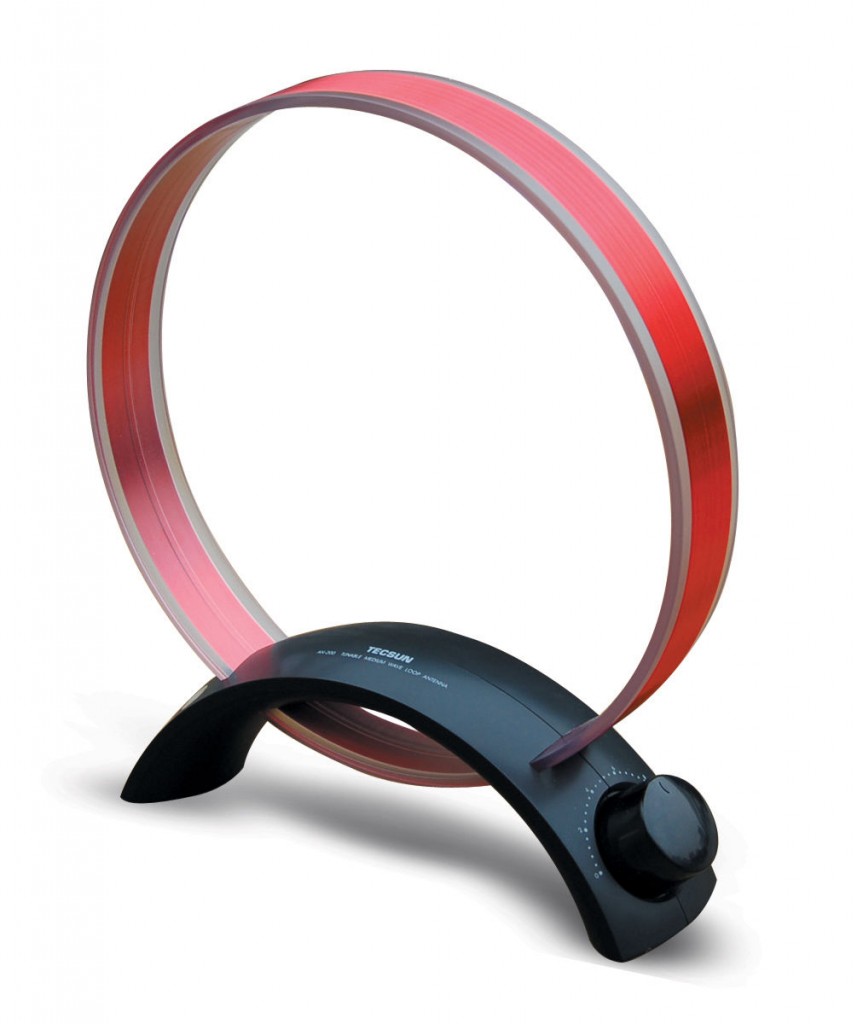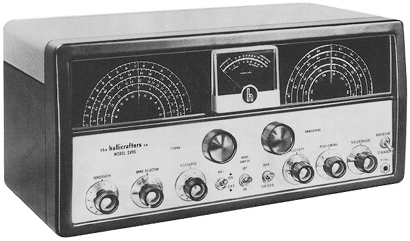Many thanks to SWLing Post reader, Larry Caracciolo, who comments:
I bought the AN-200 in the spring of 2015 off of eBay. I was favorably impressed with the product. Comparing it to my old 9′ diameter tuned/shielded loop from 1992, there are some similarities and differences.
I live in an apartment complex so plenty of radiated electromagnetic noise is present. I use a modified [Hallicrafters] SX-96 (AVC ckt was modified for improved modulation acceptance). The AN-200 does null out local static sources, somewhat, but not well enough to dig out weak stations. The tuning range for the loop is just at the bottom of the AM band (about 535 khz) to just over 1700 kcs.
On a whim, I wrapped aluminum foil around the loop and grounded it to the SX-96 chassis – in wistful hope of achieving some shielding from the RF has. As soon as I connected the aluminum foil ground clip to the rx chassis, all RF noise ceased and signals appeared from the mud. However, the tuning range is attenuated above 1200 kcs.
My favorite frequency on the AM band is 590 kcs. During the night, as many as seven different stations rose from the noise and provided station IDs at just the right moment. My best catch here in Everett, WA is KCSJ, a 1KW station in Colorado Springs.
From time to time, stations on the low portion of the AM band are accompanied with echoes – what I took for two stations and a small time delay between the same broadcast was actually multi-path to the degree that nearly 1/2 second separated the arriving signals. Short-delayed echoes, anyone? I’ve not observed this on frequencies above 1000 kcs.
Other sources of RF noise can come from the laptop, the cable modem, and even CFBs in other rooms. For truly noise-free listening environment, I place the laptop in sleep mode and unplug the cable modem. I’m quite happy with the AN-200 loop. Affordable, easy to use, easy to tune.
Thanks so much for sharing your experience with the AN200 loop antenna, Larry!
As anyone who grew up in the era of TV rabbit ears knows, aluminum foil can simply work magic in a pinch! There is no easier material to work with either!
As I pointed out in previous posts, the AN200 loop antenna is quite affordable. I just did a quick price search:
- The Tecsun equivalent of this antenna (the AN100) is available from various sellers on eBay from about $15 – $30 US.
- The Kaito AN200 (Kaito’s branded version) is available on Amazon for $30 shipped.
- With the purchase of the Eton-Grundig Traveler III, Eton-Grundig Field, or Eton-Grundig Satellit, Universal Radio will include a free AN200 with your purchase.



Hi DL4NO,
Thanks for that. The antenna I have made does indeed have a BNC socket which will or should connectnicely against the shielded box for when I am connecting it to a radio. Most of the time I just inductively couple it to my Sony portable and it is then I am not sure what to do, if anything. Thks.
Hello everyone I have read this article with much interest as I have a nice 70 cm tuned loop for longwave and non-directional beacons but I made myself with ribbon cable. It works a treat until the neighbours start putting on electrical devices and that has what got me thinking about shielding it with aluminium foil.
One question if I may: I am using portable receivers like the Tecsun PL660 and Sony SW7600D and I’m not sure if I need to ground the foil to, for instance, the battery – ve terminal as the chassis is plastic. Or maybe even to the ground side of the loop’s tuning capacitor?
Any suggestions would be much appreciated. Thks. 73.Adam M6RDP
The natural connection point of the shield is the shield of the coax cable at the antenna. Do not forget the current yoke on this cable!
If you don’t know what a “current yoke” or “common-mode yoke” is – it goes by many different names: Get a ferrite ring and wind the coax several times through this ring.
Hi DL4NO,
Thanks for that. The antenna I have made does indeed have a BNC socket which will or should connectnicely against the shielded box for when I am connecting it to a radio. Most of the time I just inductively couple it to my Sony portable and it is then I am not sure what to do, if anything. Thks.
Hello everyone. Appreciate all the comments; it’s been 6 yrs since I posted this article, and hv made many tweeks to improve performance. Tho just wrapping foil around the loop gave the best bang for the buck.
1) I did not wrap the loop entirely with foil; I left unwrapped the portion of the loop between the black table rests. Emulating a rather large “air” gap. Nearly all static and CFB buzz disappeared.
2) Very low-level computer hash and cable modem hash masked very weak signals during night-time sessions. The has can be eliminated by turning off the computer; the cable modem hash can be reduced by playing with modem orientation on the floor.
3) High end tuning was dramatically reduced from 1600kHz down to about 1200kHz. Likely due to capacative coupling btwn coil and foil shield.
4) I tried using large rolls of toilet paper slid over the main coil, wrapping the TP rolls with foil, in hopes of widening frequency response. No joy. A lot of work using tin snips to chop thru TP and cardboard roll 😉
Best night-time DX has been KCSJ, a 1KW station in Colorado Springs. There’s a Mexican broadcaster on 540kcs which battles it out with a Canadian stn same freq (about 1500 miles NE of my location).
I replaced the foil today (6/6/2021) but the tuning has changed for some reason. I cannot peak below 540kcs. Not sure why.
Photos of the “foil encased” loop coming soon!
have tecsun pl-660 and tecsun 200 loop antenna and as early as 21:56 utc hearing 4 north Americans on am mw band at reception good including a station in St, louis and wbbr 1130 does not allways need a loop as wbbr strong reception, what im after now are South Americans on the am mw band as recently heard bonaire on 800 trans World radio religious program heard, 73, jon collins, birmingham, middle of the uk ??
Did Larry wrap the entire antenna (completely cover it) with foil or did he leave a small gap around the circumference. I can’t see how the antenna would pick up anything if it was completely covered like a Faraday shield.
Sounds like a great way to max out the performance of this antenna…and useful for antenna projects.
Phil
If he had covered the antenna completely he would not hear anything with it.
BTW: Such shielding is only good for very small antennas (relaive to the wavelength). Otherwise you get quite some unwanted effects.
You’re correct, that’s what I said. So I was wondering if he left a gap along the circumference.
A picture would be wonderful
Electrostatic shielding of magnetic antenna has been known for at least half of a century. I remember a Saba radio from the late 1950s with a ferrite rod antenna that had a mesh shield and could be turned with a knob on the front.
As far as I remember the magnetic rod was some 15 cm long. The shield was a bit shorter and had perhaps 5 cm diameter. Another example is here: http://www.radiomuseum.org/r/saba_lindau_gw4.html